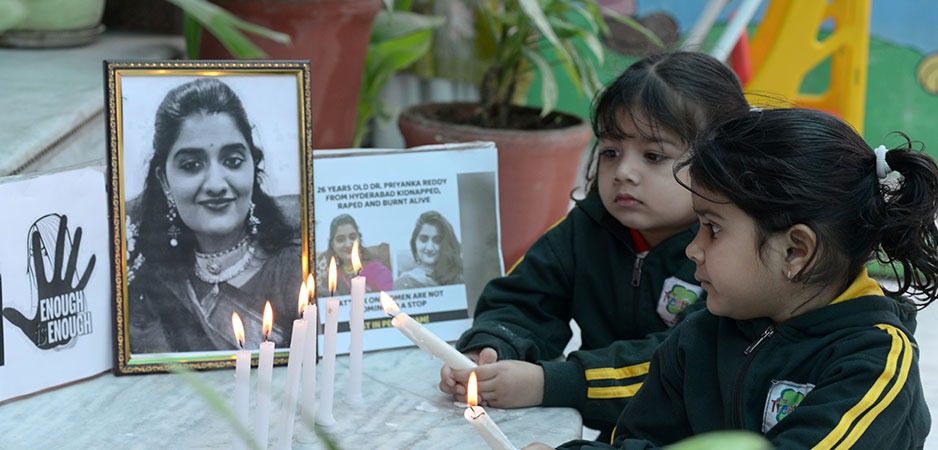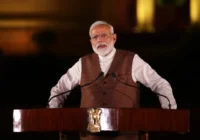Journalist Priyanka Dubey, in her book “No Nation For Women — Reporting on Rape From India, The World’s Largest Democracy,” boldly remarked that “rape is the only crime in India for which the victim is blamed.” The statement makes absolute sense in the light of India’s social context, where a woman is shunned for inviting upon herself the trouble of rape. The topic has again been dominating the national discourse following the brutal gang rape and murder of Priyanka Reddy, a 25-year-old veterinarian from Hyderabad.
It echoes the dark day in December 2012 when Jyoti Singh — nicknamed “Nirbhaya,” or fearless — a 23-year-old physiotherapy student in New Delhi, was brutally gang-raped by six men aboard a moving bus; she did not survive her horrific injuries. The incident sent shockwaves throughout the country and internationally, with protesters calling for the government to take action. It marked a watershed moment when people united in one rallying cry, questioning women’s safety and the abhorrent patriarchal system that commodifies women, demanding harsher punishment for rape.
As a result, the Criminal Law (Amendment) Act of 2013 brought in new provisions and expanded the definition of rape. Under Section 376A of the Indian Penal Code, cases resulting in the death or causing a persistent vegetative state became punishable by no less than 20 years in prison, extendable to imprisonment for life or a death sentence. The Protection of Children from Sexual Offences Act was introduced in 2012, and its 2019 amendment calls for the death penalty in case of aggravated penetrative sexual assault committed against a child. Prior to this, the Criminal Law (Amendment) Act, 2018 introduced the death penalty in case of rape against a girl under the age of 12 — boys weren’t mentioned — even if it didn’t result in death.
Can a Brutal Murder Shake India into Facing Its Rape Culture?
But it would be a misstatement to suggest that, seven years on, anything has changed for the better in reality.
If something has changed, it is the number of rape cases, which has grown from 38,385 in 2014 to 41,761 in 2016, while the conviction rate is still hovering at 25%. In 2013, the Justice Verma Committee, set up to amend India’s rape laws, recommended setting up fast-track courts and added lifetime imprisonment for rape in hope of deterring would-be rapists. But according to the data recorded by the National Crime Records Bureau, a woman is raped in India every 20 minutes, and only 10% of those cases are reported to the police.
What is chilling is that in 98% of the cases, the accused is someone known to the victim. If a man is known by the company he keeps, a woman is likely to be raped in the company she keeps.
Theory of Rape
What makes matter worse is that women who become victims of such crimes are subjected to victim-shaming on an unprecedented scale. From pointing out what she was wearing, who she was with, her bad habits such as smoking and drinking, or the fact that she stepped out at an indecent time, the rape victim is accused of becoming a victim of rape. Scholarship on the subject that offers a number of theories on the causes of rape is completely disregarded.
The commodification theory focuses on how women and their sexuality have for long being treated as a commodity. Hence the pervading perception among men that sex must be available. This stirs a perception that a man can have sex with a woman as and when he desires. This is not even remotely surprising in an Indian context, where a woman is treated like a commodity in every sense. The term “paraya dhan” — estranged money — is imputed to a daughter from the minute she comes into the world. After marriage, a woman becomes the property of her husband, who is given unguarded liberties to exercise his sexual whims upon his wife.
It is perhaps unsurprising, then, that India is the third-largest porn-viewing country. In the mainstream, Bollywood films — and the loathsome stereotypes they propagate — reinforce the commodification of women and their sexuality, in awe of the stereotypical macho hero.
The developmental theory explains that rapist tendencies emerge as a result of one’s surroundings as well as upbringing. Those who grow up seeing violence inflicted upon women — or see violence as a way to attain their own satisfaction — often resort to violence themselves. Indian society is notorious for violence happening behind closed doors. Women are told to hide their wounds and maintain their happily-married image to prevent the souring of marital relations. Beating the drum of agony in public has been considered against the “culture.”
The Nirbhaya rapists fit well into the development theory. In an interview, one of the accused pointed out that the victim going out late at night was the reason why they decided to “teach her a lesson.” He held the opinion that she invited rape by breaking the moral grounds laid by the society that demanded her to stay home and keep house instead.
The gender-based hate crime theory sees hate toward the opposite sex as fueled by the patriarchal norms. This exhibits not merely disrespect for women but also instigates unbridled violence against them. In a patriarchal society like India, where a woman is designated certain roles and attributes, the theory fits better. Despite the fundamental right to equality enshrined in Article 14 of India’s Constitution and various attempts by the state to empower women, implementation is still far-fetched.
The control theory has been used by feminists to link sexual violence and abuse as a way of gaining control over the opposite sex. What is pertinent about this theory is that it reflects the grim picture of women in society who are crushed under the patriarchal system of control. This further reinforces gender inequality in a society that claims to bring the two sexes on par with each other.
Justice Must Be Done
In the Indian context, all these theories often intertwine, weaving a harrowing narrative of women’s daily reality, laying bare the many reasons why, despite stringent laws, men continue to rape women. This is the reason why, when society conveniently puts the blame on the woman, justice seems unattainable.
This is the reason why, despite having access to law, the family of the victim often brushes the matter under the carpet. Not only is the woman subjected to the callous narrative constructed by society, but her entire family is subjected to social harassment. A rape victim who survives the assault often dies a painful social death, often unable to marry or ostracized by her own family, discarded as “impure.”
All said and nothing done, the Justice Verma Committee failed to bring in the desired changes. There was also a failure to recognize the death penalty as an effective deterrent for rape. India, which has ratified the International Convention on Civil and Political Rights as well as the Convention on Rights of the Child, hasn’t abolished death penalty, but is used very rarely. This guideline was laid in the 1980 case of Bachan Singh v. State of Punjab, and the death sentence is only awarded by looking at all the aggravating factors, keeping in view the nature of crime as well as the criminal.
The Nirabhaya case was so heinous, that it earned the perpetrators — except for the minor, who received the maximum sentence of three years — the highest punishment possible. But while life imprisonment is the rule, the death sentence is an exception. The state has ruled that a right to life is paramount and those who are guilty of robbing someone of this right must be punished accordingly. But why doesn’t the state — as the protector of human rights — recognize that a woman who becomes the victim of the crime of rape is essentially robbed of her right to live in society?
Not only should justice be done, but it must also be seen to be done. A death sentence must be the rule in the case of rape — life imprisonment should be the exception. There is no reason why a punishment of a lesser magnitude must be given to those who leave permanent psychological scars.
Taking Responsibility
Politicians try giving these crimes a communal color or resort to mere public displays of sympathy. More often than not, the state governments pass the responsibility to the central government, and vice versa. But what can we expect when our lawmakers are, in fact, law-breakers, with records of heinous crimes decorating their CVs. According to a report by Association of Democratic Reforms, 189 candidates, or 20% of those contesting seats in the Lok Sabha (India’s lower house of Parliament) elections in 2019, had pending criminal cases, 21 of which were crimes against women. This explains why our lawmakers can offer no more than sympathy when it comes to matters of justice.
It is high time the state recognizes its responsibility toward women. Women don’t need farcical empowerment initiatives. Women don’t want to hear television debates on who has the onus of safeguarding their rights. Women don’t care which party is in power. Be it right-wing or left-wing, each government has the responsibility to protect women, regardless of its ideology.
There is no better time than now to bring in changes to the narrative around rape that compels the victims to muffle their pain. Education is key. First of all, the government must stop focusing on raising the literacy rate, which in reality is devoid of any value, and must instead focus on the quality of education available to all sectors of the population. Sex education, which is outrightly taboo in India, needs to be introduced into the system so adolescents understand their bodies and desires better.
Secondly, it is necessary to spread gender and sex literacy at the local, grassroots levels through workshops, radio talk shows and educational camps. The entrenched psychology of the patriarchy will not be crushed in a day. That will take its own course, but we must strive to instil a sense of equality and eliminate gender roles by projecting them by means of entertainment. Films, ads, soap operas and other forms of entertainment promoting gender bias or gender-based violence must be banned.
If the Indian government decides to usher in efforts to reform the redressal system for rape claims, educate both the population and the law enforcement agencies, mete out serious deterrent punishments and, most importantly, ensure protection to victims, India’s endemic rape culture may one day become but a chilling memory.
The views expressed in this article are the author’s own and do not necessarily reflect Fair Observer’s editorial policy.
Support Fair Observer
We rely on your support for our independence, diversity and quality.
For more than 10 years, Fair Observer has been free, fair and independent. No billionaire owns us, no advertisers control us. We are a reader-supported nonprofit. Unlike many other publications, we keep our content free for readers regardless of where they live or whether they can afford to pay. We have no paywalls and no ads.
In the post-truth era of fake news, echo chambers and filter bubbles, we publish a plurality of perspectives from around the world. Anyone can publish with us, but everyone goes through a rigorous editorial process. So, you get fact-checked, well-reasoned content instead of noise.
We publish 2,500+ voices from 90+ countries. We also conduct education and training programs
on subjects ranging from digital media and journalism to writing and critical thinking. This
doesn’t come cheap. Servers, editors, trainers and web developers cost
money.
Please consider supporting us on a regular basis as a recurring donor or a
sustaining member.
Will you support FO’s journalism?
We rely on your support for our independence, diversity and quality.






